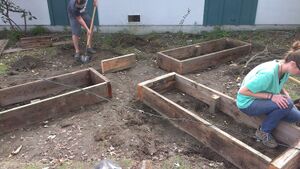
Community gardens are an excellent way to bring local people together and take action towards a more sustainable way of living in your own neighborhood.
This page is a guide on how to start one from scratch. Here you will find ideas on how to get some people, find some land, set some rules, and finally grow some plants.
Step 1: Get some people[edit | edit source]
After all, it is a community garden. If you don't have three or four families, you don't really have anything. Too few people, and too much of the work is being done by one or two people. Invite the old, invite the young, invite the local church, invite a boyscout/girlscout troup. The more the merrier. Some people will come, some people will go. More people will show up when it is time to harvest, than when it is time to weed.
Step 2: Find some land[edit | edit source]
- The closer to the community the better. Many people will not even go five minutes out of their way to swing by the garden. Once they miss a week, they will be even less likely to come back next week.
- Water is nice. Try water catchment combined with a tool shed.
- Set aside an area for composting.
- Set aside a tool shed, or some place for people to store their tools.
- Bathroom facilities ? Composting toilet project ?
- A fence is nice - especially in areas with deer. Otherwise, they will eat your sweet corn on the very night before you plan to pick it - not that I'm bitter or anything.
- Parking might be an issue, pick a place where people can get their cars and pickups close to.
If you have trouble finding enough space, you might try:
- Approach the local city planning board and ask for some space on the edge of a city park maybe.
- Drive around the community, find a nice spot, talk to the owner and explain what you want to do.
- Find an older couple/indivudual that already has a garden in the community, ask to join (expand) theirs.
- Guerilla Gardening - Do it anyway, knowing the city might come in any day and rip it all out.
Once you have the land, set aside a weekend to plow up the whole area if it has not been done before. Toss on all the compost you can, leaves, lawn clippings, everything else. Till it up, divide it into plots if you are doing separate plots. If you are thinking ahead, start the planning the summer/fall before, plow it up then, fence it, have all the prospective members toss on their grass clippings and raked leaves that year, till it up the next Spring, and it will be all the better.
Step 3: Set some rules[edit | edit source]
- Common plots, or individual areas ?
- Organic ? Not so much ? Half-n-half (put organic side upwind of the non-organic side)
- Weeding other people's plots is OK ?
- Picking other people's plots is OK ?
- Post the rules, maybe on the side of the tool shed. This is also a place for people to leave notes... eg. 'Please help yourself to the 50 bushels of cucumbers that are growing in plot A4'
- Which tools can be used by anybody ? Which cannot ?
Step 4: Grow some plants[edit | edit source]
This one is prety self-explanitory.
See also[edit | edit source]
External links[edit | edit source]
- 10 Steps to Starting a Community Garden, communitygarden.org
- Community Gardens - a very thorough booklet from community gardeners in South Australia, available from Growing Communities
Organising bodies with local information:
- America and Canada: http://www.communitygarden.org
- Australia: http://communitygarden.org.au/
- UK: http://www.farmgarden.org.uk/